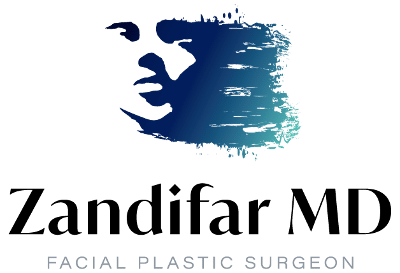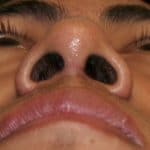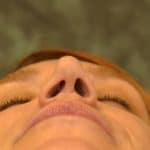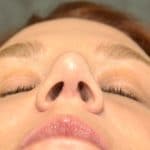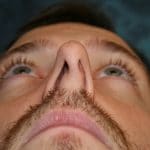Treating a Deviated Septum with a Septoplasty
Treating a Deviated Septum with a Septoplasty
Few things impact daily life, as much as the inability to breathe easily. A deviated septum, a common condition where the nasal septum is improperly formed or shifted to one side, can cause significant breathing problems, nasal obstruction, and discomfort. If left untreated, it can also lead to complications like sinus infections, headaches, and even trouble sleeping. For those dealing with these symptoms, septoplasty is a highly effective surgical solution.
This guide will provide an in-depth look at the condition, its effects, and how septoplasty can restore proper functionality to the nose and improve quality of life.
Understanding a Deviated Septum
What is a Deviated Septum?
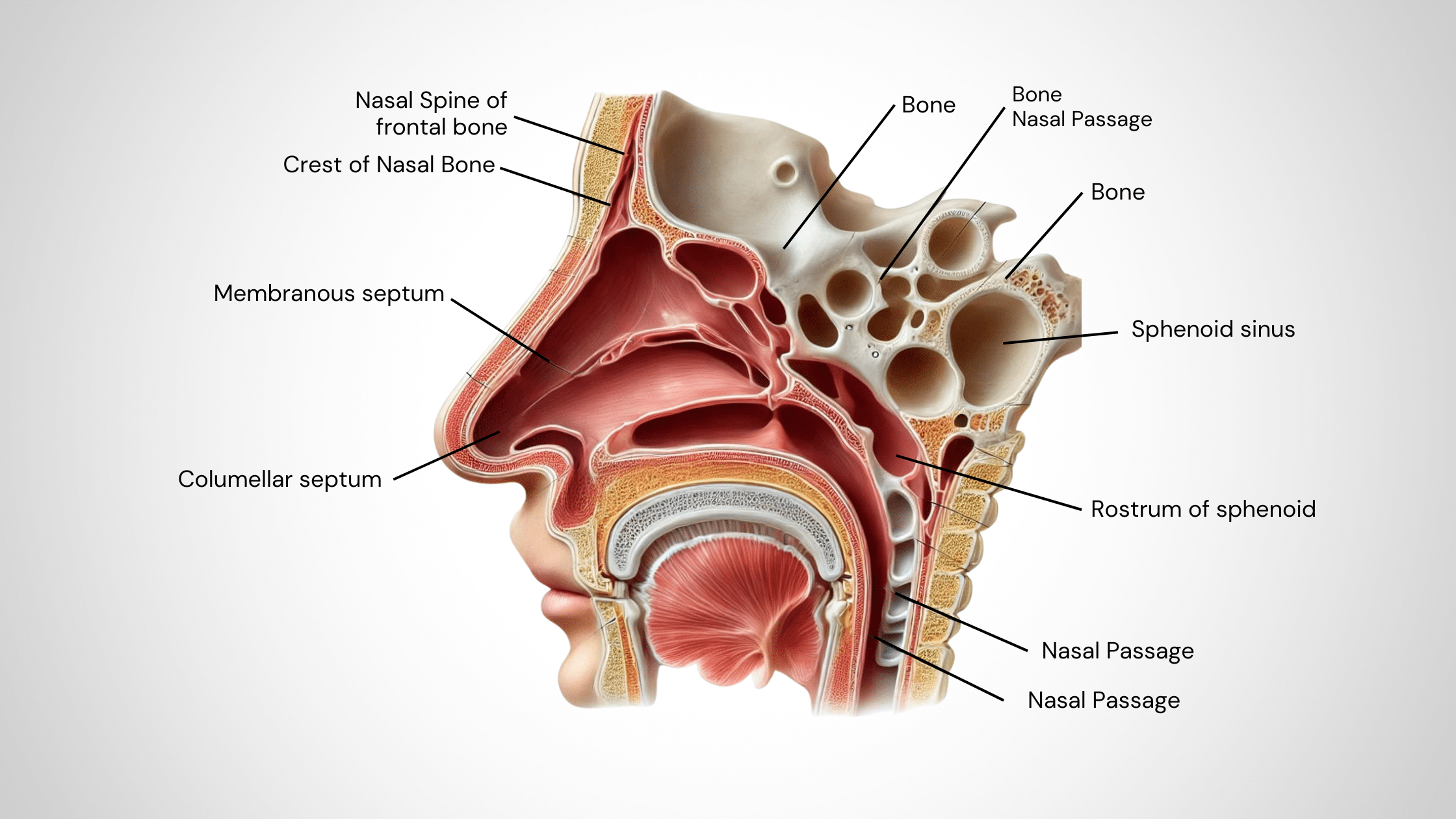
The septum is the thin wall of bone and cartilage that separates the two nasal passages inside of your nose. Ideally, the septum should divide the nasal cavity evenly into two chambers. However, in many individuals, the septum is not perfectly straight. A deviated septum occurs when this wall is crooked or improperly formed, causing one nasal passage to be narrower than the other.
This misalignment can be caused by congenital factors, trauma to the nose, or other conditions that affect the bone and cartilage structure. While minor cases may not present noticeable symptoms, more severe deviations can obstruct airflow, leading to difficulty breathing through your nose and other issues. To learn more about the nasal septum and its role in respiration, refer to this article from the National Center for Biotechnology Information (NCBI).

A deviated septum can manifest in a variety of ways, including:
- Nasal obstruction: Difficulty breathing through one or both sides of your nose.
- Frequent sinus infections: The blockage of nasal passages can create an environment conducive to infections.
- Headaches and facial pain: Pressure caused by uneven airflow and nasal tissues pressing against each other.
- Stuffy or runny nose: Persistent congestion or dripping can be indicative of a septal deviation.
- Snoring or noisy breathing during sleep: The narrowed nasal passages often exacerbate breathing problems at night.
- Needing to sleep on a specific side: Some individuals unconsciously adjust their sleeping position to accommodate their breathing.
If you experience these symptoms frequently, addressing them with a treatment plan such as endoscopic sinus surgery may help alleviate complications.
Causes and Risk Factors
A deviated septum may result from several factors:
- Congenital conditions: Many individuals are born with a deviated septum due to developmental issues.
- Trauma: Injuries to the nose, such as from sports or accidents, can shift the septum.
- Aging: The cartilage and bone in the nose can change over time, exacerbating the septal deviation.
- Inflammatory conditions: Chronic swelling from allergies or sinus infections may further narrow the nasal cavity.
Why a Deviated Septum Affects Quality of Life
Impact on Daily Activities
The nasal passages play a vital role in breathing and overall well-being. A deviated septum often causes difficulty breathing through your nose, affecting everyday activities like exercising, working, or even relaxing. Those with a deviated septum may also experience trouble sleeping due to nasal blockage, resulting in fatigue and reduced productivity.
Long-Term Health Risks
If left untreated, a deviated septum can contribute to chronic sinus infections, recurring nosebleeds, and other complications. Over time, this may cause irreversible damage to the nasal tissues. Surgical solutions, like balloon sinuplasty, can prevent these issues by addressing nasal obstruction effectively.
Why Consider a Septoplasty?
Benefits of Septoplasty
Septoplasty is a reconstructive procedure designed to straighten the nasal septum, restoring proper airflow through the nasal passages. The benefits include:
- Improved breathing: Straightening the septum ensures both nasal passages are open and functional.
- Reduced sinus infections: Better airflow helps prevent blockages that lead to infections.
- Enhanced sleep quality: Correcting a deviated septum can alleviate snoring and other breathing problems at night.
- Improved quality of life: From exercise to simple tasks like breathing, many aspects of daily life are positively impacted.
When to Seek Medical Advice
It’s important to consult with an ear, nose, and throat specialist or facial plastic surgery expert if you experience persistent nasal obstruction, sinus infections, or other symptoms that interfere with daily activities. A proper diagnosis is essential for determining whether septoplasty straightens the issue effectively.
Myths and Misconceptions
There is a common misconception that septoplasty is purely a cosmetic procedure. While it can improve the external appearance of the nose in some cases, its primary purpose is functional—restoring breathing and resolving nasal blockages. Unlike major surgery, septoplasty is often performed on an outpatient basis and focuses on the internal structure rather than the outward appearance.
The Septoplasty Procedure: Step-by-Step Guide
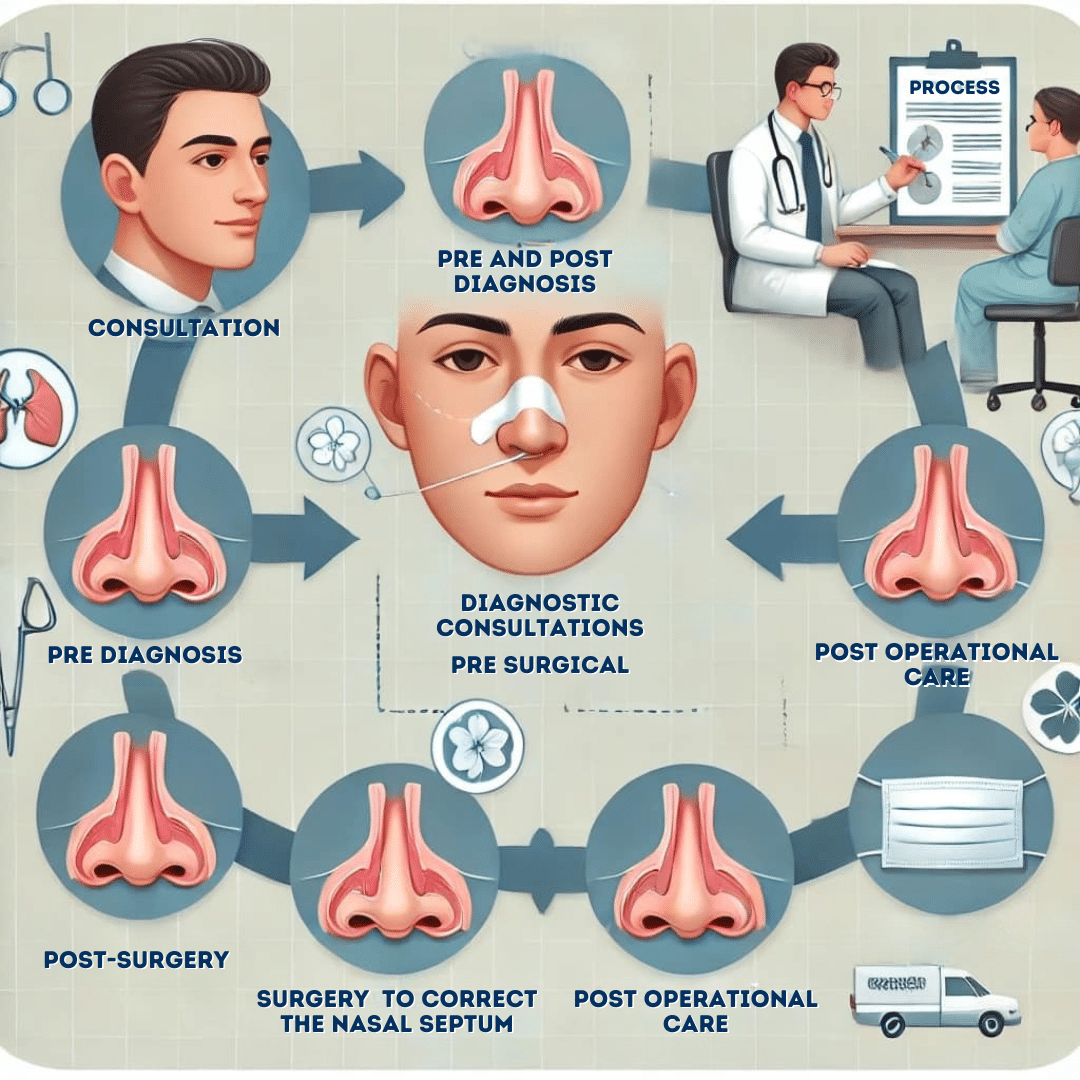
Preparing for Surgery
Before undergoing nasal surgery, your surgeon will review your medical history and perform a thorough examination. Tests such as X-rays may be conducted to assess the severity of the septal deviation. The surgeon will also discuss pre-surgical preparations, which typically include:
-
Avoiding certain medications: Blood thinners like ibuprofen, Advil, or Motrin should be discontinued to prevent bleeding risks.
-
Fasting: Patients are usually advised to refrain from eating or drinking after midnight before surgery if general anesthesia is used.
-
Managing allergies and infections: Pre-existing conditions, such as sinus infections, must be treated to ensure the best outcome.
During the Procedure
Septoplasty is generally performed as an outpatient procedure, often in an outpatient surgery center. Depending on the case, the surgeon may use local anesthesia or general anesthesia to ensure patient comfort. Once anesthetized, the surgeon carefully adjusts the bone and cartilage of the septum. In some cases, deviated sections are removed entirely to improve airflow.
The procedure also minimizes damage to the nasal tissues, which enhances the healing ability of the nose and ensures minimal scarring. Advanced techniques, as outlined in medical resources like Cummings Otolaryngology, make septoplasty a highly effective and safe option.
Recovery and Aftercare
After surgery, patients are monitored briefly before being discharged. Recovery guidelines often include:
-
Keep the head elevated to reduce swelling.
-
Avoid heavy lifting or vigorous activity for a few weeks.
-
Use saline sprays or nasal steroid sprays to keep the nasal cavity moist and prevent bleeding.
-
Avoid medications like ibuprofen to further reduce bleeding risks.
Patients can expect some discomfort, minor bleeding, and a runny nose during the initial recovery phase. However, these symptoms typically subside within a few weeks, and most individuals return to normal activities shortly after.
Real Results: Before-and-After Transformation
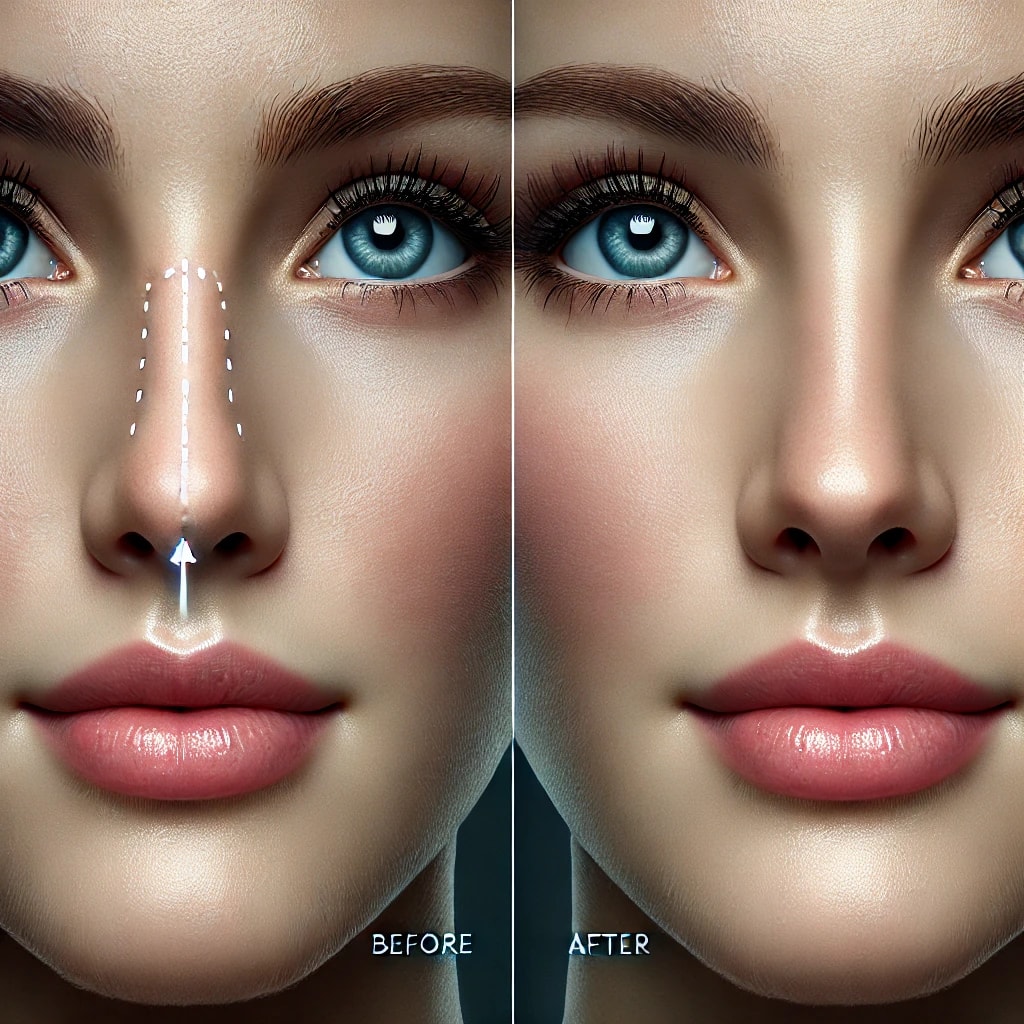
Case Studies and Testimonials
Patients who have undergone septoplasty report significant improvements in breathing and quality of life. Stories of reduced snoring, fewer sinus infections, and increased energy levels highlight the transformative potential of this procedure.
Visualizing Results with Before-and-After Images
Images comparing pre- and post-surgery outcomes help patients understand the effectiveness of septoplasty. These visuals also provide a glimpse into the improved functionality of the nasal passages and, in some cases, subtle enhancements to the external appearance.
How to Make an Informed Decision About Septoplasty
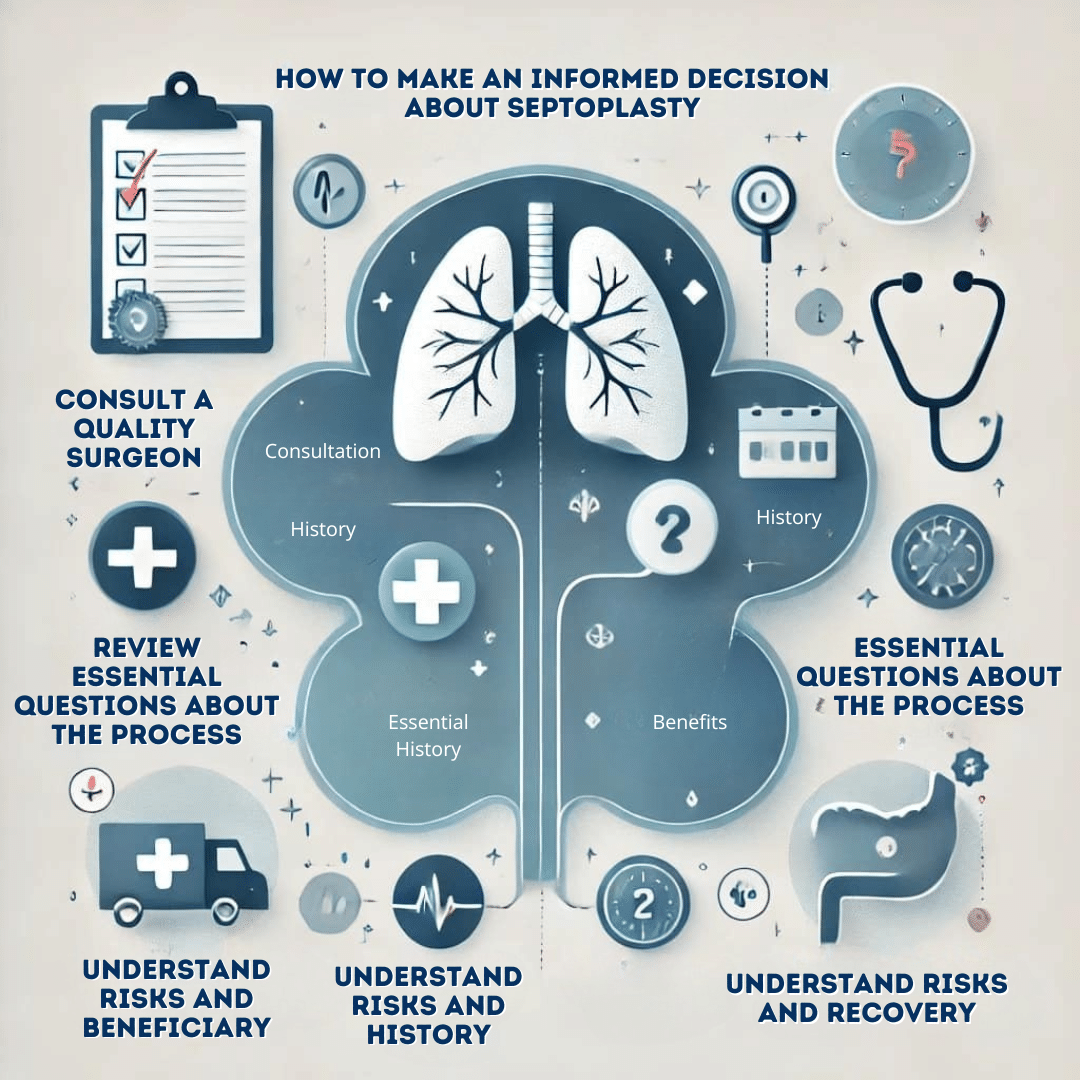
Questions to Ask Your Surgeon
Before proceeding with surgery, it’s crucial to have a clear understanding of the procedure and its implications. Consider asking:
-
What techniques will be used to address my deviated septum?
-
Will I require general anesthesia or local anesthesia during the procedure?
-
How long will the surgery take, and what is the expected recovery time?
-
Are there any risks specific to my condition, such as bleeding problems or delayed healing ability?
-
Can you show me before-and-after photos of similar cases?
These questions help set realistic expectations and foster trust in your surgeon’s expertise.
Factors to Evaluate Before Choosing Surgery
The Severity of Symptoms
If you experience significant trouble breathing, frequent sinus infections, or persistent nasal blockage, surgery may be necessary to restore function and comfort.
Overall Health
Discuss your medical history with your surgeon to ensure you are a suitable candidate for surgery. Conditions like high blood pressure or clotting disorders should be managed before proceeding.
Lifestyle Considerations
Septoplasty requires a recovery period during which activities like heavy lifting or rigorous exercise must be avoided. Make sure your schedule allows for proper rest and aftercare.
Understanding the Recovery Commitment
Recovering from septoplasty involves more than physical healing; it also requires adherence to aftercare guidelines to prevent complications. Key aspects include:
-
Avoiding ibuprofen, Advil, or Motrin to prevent bleeding.
-
Using saline sprays to keep the nasal tissues hydrated.
-
Keeping your head elevated to minimize swelling and encourage proper drainage.
-
Scheduling follow-ups with your surgeon to monitor progress.
Patients who follow these recommendations typically experience a smoother recovery and better long-term results.
FAQs
What is septoplasty, and how does it help with breathing problems?
Septoplasty is a type of reconstructive plastic surgery performed to correct a deviated septum by straightening the bone and cartilage that divide the two nasal passages. By doing so, it alleviates nasal blockage, improves airflow, and resolves breathing problems.
Is septoplasty a major surgery?
While it is considered a surgical procedure, septoplasty is usually performed on an outpatient basis. This means most patients can return home the same day. Advances in surgical techniques make it a safe and effective option.
Does insurance cover septoplasty?
Many insurance plans cover septoplasty if it is deemed medically necessary. This typically includes cases where the deviated septum causes chronic trouble breathing, sinus infections, or other related issues. Patients are encouraged to consult their insurance provider for specific coverage details.
How long does recovery take?
Most patients recover within one to two weeks, though minor swelling and congestion can persist for a few months. Patients are advised to keep their head elevated, avoid heavy lifting, and follow their surgeon’s aftercare instructions to ensure optimal healing.
Is septoplasty painful?
Septoplasty is not typically described as a painful procedure. While patients may experience discomfort or nasal blockage during the initial recovery phase, this is manageable with prescribed pain relief.
What Sets Dr. Zandifar Apart?
A Commitment to Excellence
Dr. Zandifar is a board-certified surgeon specializing in ear, nose, and throat procedures, as well as facial plastic surgery. His extensive expertise in reconstructive plastic surgery ensures that each patient receives personalized care tailored to their specific needs. With a track record of successful outcomes, he is highly regarded for his ability to combine septoplasty with other nasal surgeries when necessary to achieve the best results.
Facilities in Beverly Hills and Santa Monica
Conveniently located in Beverly Hills and Santa Monica, Dr. Zandifar’s outpatient surgery center is equipped with state-of-the-art technology. Patients benefit from a comfortable environment designed for both minor procedures and more complex nasal surgeries. From the initial consultation to post-operative care, the clinic emphasizes patient comfort and satisfaction.
Personalized Consultations and Care Plans
Dr. Zandifar takes a patient-first approach, carefully assessing each individual’s condition and medical history before recommending surgery. By providing a thorough explanation of what to expect, he ensures that patients feel confident and well-informed. This level of care extends beyond the operating room, with follow-ups to monitor healing and ensure long-term success.
Schedule Your Consultation Today
If you’re struggling with breathing issues caused by a deviated septum, Dr. Zandifar can help. With expertise in septoplasty and reconstructive solutions, he offers personalized care to improve your breathing and quality of life. During your consultation, Dr. Zandifar will assess your condition, review your medical history, and recommend the best treatment plan.
Dr. Zandifar’s offices in Beverly Hills and Santa Monica provide state-of-the-art facilities for your care. To book your consultation, call 310-736-4272 or visit Zandifar MD, to schedule online. Don’t wait to contact us. Address your symptoms now and take the first step toward better breathing and overall comfort.
A Commitment to Excellence
Hootan Zandifar, MD, FACS, Board Certified Facial Plastic & Reconstructive Surgeon
FAQ
When Should You See a Doctor for a Deviated Septum?
The best time to see a doctor for a deviated septum is when you feel like you can’t breathe well through your nose. This may be more noticeable during exercise, meditation, or sleeping and less noticeable when awake.
What Are the Treatment Options for a Deviated Septum?
The only true treatment option for a deviated septum is surgery. A deviated septum is basically a crooked wall inside your nose that blocks the passage of air. There is no medication or at-home remedy that can improve this condition.
Will Insurance Cover a Septoplasty?
To see if your health insurance plan covers the cost of a septoplasty as well as what out-of-pocket cost you can expect to pay, please contact our office.
What is Deviated Septum Surgery?
Nasal septum reconstruction, also known as a septoplasty, is a reconstructive surgical procedure done to treat nasal blockages. It is performed entirely through the nose, which leaves no external scars. Through this approach, Dr. Zandifar can straighten a patient’s septum and greatly improve their ability to breathe.
How Painful is Deviated Septum Septoplasty?
Although it can be a little uncomfortable, deviated septum surgery is not very painful and most patients tolerate it very well.
Is Deviated Septum Surgery Worth It?
If done properly on a patient who is suffering from poor quality of life due to a deviated septum, septoplasties leave most patients highly satisfied.
Schedule Your Consultation
If you are suffering from the discomfort of a deviated septum, Dr. Zandifar can help. Book your consultation today to learn more about how a septoplasty can change your life for the better!
Beverly Hills Office
8920 Wilshire Blvd, Suite 604
Beverly Hills, CA 90211
Santa Monica Office
2811 Wilshire Blvd, Suite 640
Santa Monica, CA 90403

